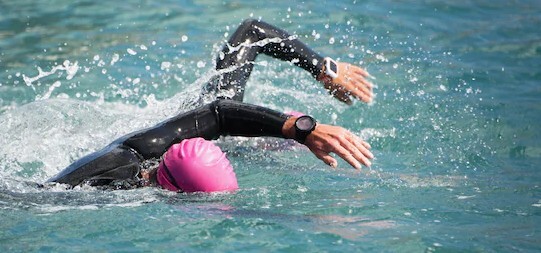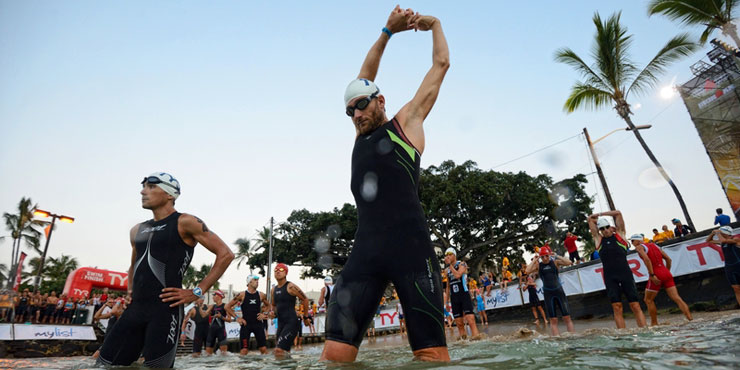The Pacific Ocean is like a second home to me. I'm from Southern California and have been an ocean swimmer for six years. Swimming along California's beautiful coastline gives me a unique opportunity to pause life and focus on myself, get in touch with nature, and train my body in real-life physical conditions.
If you're an open water distance swimmer, you probably know what I'm talking about. Learning the ins and out of open water swimming inspires me to share what I know. Hopefully, I can give a leg up to anyone looking for an opportunity and a challenge. Here are key triathlon swimming techniques to be competitive in an open water triathlon…

A Strong Swim Session Routine
In competitive distance swimming, the ‘who’ is just as important as ‘how’. Before you get in the water, you’ll want to find your people. If you live in the United States, joining your local US Masters Swimming club is an excellent way to stick to a dedicated training schedule, receive coaching, and build endurance in your swimming workouts. The best part: you get to train with people equally as passionate about and committed to swimming.
US Masters Swimming: https://www.usms.org
Close to the triathlon, train in open water where you’ll be competing. Pay attention to the details of the course--challenging parts and others where you’ll want to push yourself. On race day, you’ll feel more confident knowing you’ve already covered the course multiple times. When practicing, bring a couple friends to hold a pace with.

An Effective Warm-Up
You already know that warming up properly before you swim is crucial for your health and a productive practice. These are essential exercises for any swimmer before getting in the water…
- Arm circles: 20 forward, 20 backward
Rotate your arms slowly and in alternation (one arm high above your head, the other by your hip). Keep your elbows locked and allow your upper body to twist as needed for full reach.
- Shoulder stretch: 20 seconds each arm
Pull your arm across your chest without straining your shoulder. Hold for 20 seconds. Same for the opposite arm.
- Push-ups: 15-20
Push-ups help activate your shoulder muscles before you swim. Gradually increase the number of push-ups you do to strengthen your shoulder and core muscles.
- Crunches: 30
Crunches remind your body to engage your core muscles when you’re in the water, rather than relying on your lower back. Keep your chin off your chest, never pull on your head.
- Hamstring, quad, calf stretches: 30-60 seconds each leg
These muscle groups will be tense when you swim. To prevent cramping or future injury, stretch each for at least 30-60 seconds before swimming.
- Neck rolls, clockwise & counterclockwise
Your neck and back muscles help you come up to breathe. Lightly roll your head clockwise and counterclockwise. Don’t stretch beyond what feels natural.
Cool-Down—A Must!
Even though it’s called a cool-down, staying warm is the number one thing you need to do after swimming. Take it easy on your body after working out, since your muscles will already have micro-tears. Take advantage of this natural strengthening process and improve your flexibility with these stretches…
- Shoulder stretch: 30 seconds (on and off) each arm
Hold for 10 seconds, release for 3 seconds. Repeat two more times. Letting your shoulders relax briefly before stretching them again will protect your muscles against strain.
- Hamstring, quad, calf stretches: 30-60 seconds each leg
If you need longer than a minute to stretch your legs, make sure to keep releasing tension for 3-5 seconds periodically to avoid overstretching.
- Crunches: 30
Building core strength takes more frequent work. Do 30 crunches using good technique. Feeling a burn in your core means you’re on your way to getting stronger.

Before Race Day
The day before the triathlon, do a light 15-20-minute swim to help you stay in touch with your body without exhausting yourself. Focus on your goals and positive thoughts. Then forget about the race and get a full night’s sleep.
On race day, warm up in open water. Do not warm up on the course to avoid exposing yourself to competitors’ potential anxieties. Warm up separately to begin focusing on your race.
During the triathlon, concentrate on your performance and how your body feels, not on how your competitors are swimming. It may help to focus on your reasons for competing in the first place.
Potential Challenges and How to Overcome Them
Safety first!
During the triathlon, if you’re having trouble swimming or breathing, float on your back and raise your arm to draw attention to yourself in case you need help. Periodically check how your body is responding to the water temperature--open water swimming can get pretty cold!
Shock to the System
Open water swimming is significantly different from the pool. Here are tips for how to adjust:
- Get in slowly, even during the triathlon. The cold temperature may make you feel like you can’t get enough air. Entering the water slowly will give your body (and brain) the time it needs to adjust.
- If you need extra time to get used to the water, float on your back, take deep breaths, splash water on your face.
- Pay attention to the direction you’re swimming. Getting pushed off-course will be unavoidable, so expect to have to redirect yourself several times during the race.
Distance
The mental aspect of the competition will be your biggest challenge. You’ll already be swimming long distances to prepare your body. During practices, actively maintain the mindset you'll use to succeed during the competition. If it helps, pretend you’re already competing.
Key to establishing the right mindset is being okay with the fact that the triathlon will probably be challenging. This may sound obvious, but coming to terms with how difficult a triathlon can be might require a more strategic approach…
Positive Affirmation
Building and maintaining confidence is critical to swimming your ideal race. Here are ways to mentally set yourself up for success:
- Remind yourself that your body is adaptable and capable of more than you think.
- Have strong motivations before entering each stage of the competition. This includes practices, right before getting in the water to race, and during the triathlon.
- Know why you want to accomplish your goals.
- Set realistic goals. Be proud of yourself whether you achieve them or not, as long as you try your hardest.
Stay Focused
Challenges are just that—challenging—because they compel us to believe they’re impossible to overcome. Knowing your motivations for taking on this challenge will help you, but what about when you’re doubting yourself during the competition?
Picture this...
Half a mile through the competition, your legs feel like lead. You can hardly get enough breath. You’re frustrated with yourself for breathing so frequently because you know it’s slowing you down.
We’ve all been there. Instead of letting these problems dictate how you swim, take a moment to recover and give your body what it needs. Float on your back. Breathe. Imagine you’ve only used a fraction of your body’s energy. Picture how relieved you’ll feel back on land.
You put your head down and finish the race. The halfway point turns out to have been the hardest part. You feel exhilarated at the finish line.
Why does thinking this way even matter?
Every time you choose to focus instead of giving up, you get that much better at solving problems that made you feel defeated. When practicing for the triathlon, practice never giving up. If you think you can’t accomplish much that day, set more achievable goals before swimming and then meet them. You’ll be a more capable athlete after overcoming a handful of critical moments when finishing, rather than quitting, mattered most.
In Less-than-Ideal Conditions
It’s race day. You look out at the water. The swell is rough and the wind strong. You’ll have a headwind the whole way. The water is much colder than expected. Open water swimming can be unpredictable; here are strategies to neutralize tough conditions…
- Even experienced open water swimmers will take more time to get used to poor conditions before committing to their race pace.
- Focus on the positive: your body is capable of more than you trained it for. Although you may not have practiced in these conditions, a tenacious mindset will get you through. Remember, this competition is about you. The tougher the conditions, the more capable you become as a swimmer.
- Pay special attention to how your body is responding to the tough conditions. Adjust your performance to match what you feel you can handle. This way, you can distribute your energy more effectively throughout the race.
Time to Get Started...
These techniques are key to any successful distance swim in the open water, especially a competitive one. Reading them, you may have been thinking about how you would adjust to using these techniques. You know your body. But you might not know which strategies will work best for you till you give them a try. The most important step, as always, is getting into the water. You’ve got this.
If you need help, hire an experienced swim coach who can help develop a customized training plan and improve your triathlon swim leg!
ABOUT SUNSATIONAL SWIM SCHOOL
Sunsational Swim School is the 🥇 #1 rated provider of private, at-home swimming lessons in America. We have specialized swim instructors for students ages 6 months to adult, beginner to advanced. Featured on ABC, CBS, Impact 100, The List and others, Sunsational instructors have a minimum of 2 years of teaching experience, are CPR certified and insured, and have collectively taught over 302,223 lessons for more than 74,415 students nationwide!



